|

Colon
|
Maritime Topics On Stamps :
Lighthouses !
|
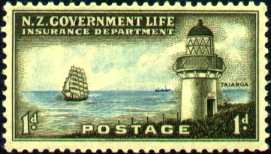
Taiaroa, New Zealand
|
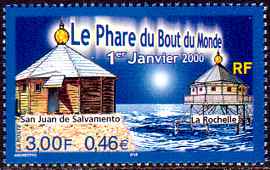
|
Women are supposed to be the first to light huge fires on cliff tops,
waiting for incoming boats with their men. The resulting light should
safely lead the boats to their port. When morning rose and some boats
were still missing another fire was lit. This way it may have begun.
Since 800 B.C. lights were installed along the coasts of the the
Mediterranean Sea. First long wooden rods and stone towers were used.
The fire was fed special wood which created extra large smoke clouds.
The clouds were visible from far away and so the signals were also
useful during daylight hours.
|
|
After 17 years of hard work a lighthouse was finished in 283 B.C. on
the Island Pharos, just off the port of Alexandria. The tower had a
height of 130m. It is the first and oldest 'real' lighthouse history
knows and he is one of the seven world wonders. 300 slaves supplied
the tower with wood to fuel the fire. It operated for nearly a
thousand years until it was partially destroyed by an earthquake in
700 A.C.. In 1307 another earthquake turned the tower into ruins.
Nevertheless all knowledge about lighthouses was named 'Pharology'
after the island.
|
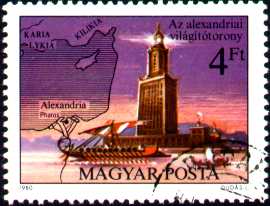
|

|
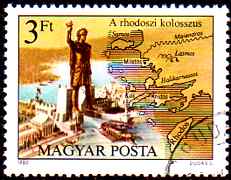
|
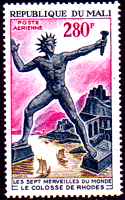
|
The 'Coloss of Rhodos' was a huge statue of the Greek sun god
'Helios'. The bronze sculpture stood at the entrance of the port of
Rhodos for over 60 years. As with the lighthouse of Pharos it was
destroyed during an earthquake in 224 B.C. The right hand of the
statue held a basin containing a fire. This tower belonged to the
seven world wonders as well.
The Roman Empire was interested in safe passage to their colonies as
well and built more and more lights along the coasts of the
Mediterrian Sea. These lights could be seen from up to one to three
nautical miles.
After 500 A.C. the lights fell into disarray as the vikings plundered
the coasts.
|
|
Some monks started anew building lighthouses in the 12th century. Then
some lights were build by people who would collect money from the
ships when they entered the next harbour. And some lights were simply
build for ship robbery: Ships, following these lights ran ashore and
became booty of the beach robbers. The surviving sailors were killed.
On this stamp of the Bahamas the sailing vessel is running on the
cliffs just in front of the lighthouse (wrecking in the 1800's).
|
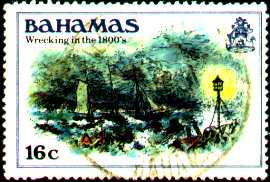
|
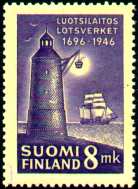
|
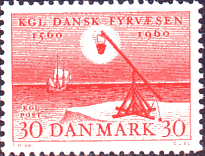
| |
The optical lens was well known since the 13th century, but was not
used for lighthouses then. One took wood, candles, lamps with oil or
stone coal to fuel the fires. The visibility was about two to three
nautical miles. In 1323 a lantern with glass windows was introduced
shield the candles from the wind on the Isle of Wight. But there still
remained a lot of buildings with open fires. Most of them fueled with
coal. On this Finnish stamp you can see the lighthouse Utö. Build
in 1753 it had two separate lights: An oil lantern on the top and a
basket with a coal fire on the side . The tower was also a pilot
station. Since the 16th century many so-called 'swinging'-fires were
constructed in the Scandinavian area. You can see one on the Danish
stamp. The mast could be easily lowered for better maintenance..
|

| |
The lighthouse of Alderney with his different lights during the last centuries.
From left: 1725 coal fire, 1779 oil lantern, 1790 Argand lamp (oil lamp with tank and tin cylinder over the flame),
1818 a rvolving apparatus and 1952 electrification.
|
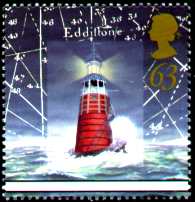
|
On this stamp we see Eddystone lighthouse. It was build and rebuild
three times. The first time, in 1709, the light consisted of a set of
candles. In those days different experiments were conducted to raise
visibility. At the Turkish Bosporus a light burned consisting of 20
oil lanterns. English people developed double lights, others placed
the candles before a polished basin for maximum reflection. At
Liverpool they used a concave mirror, a very short time later the
parabolic mirror followed. These improvements extended the range of
the lights up to 5 to 8 nautical miles. In 1768 Swedish people
constructed a rotating apparatus. Using this construction it was
possible to create flashing lights. A lot of improvements followed in
short succession. The Swiss Argrand developed a lantern with a hollow
wick. The streaming air went through the hole and took care for better
burning of the oil. These lanterns became standard in lighthouses for
many years to come.
|
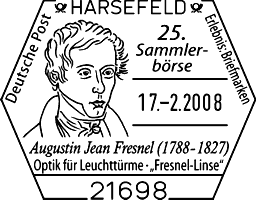
| 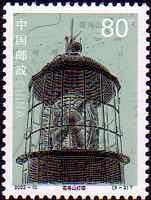
| |
The French physician Fresnel succeeded with the decisive breakthrough.
He constructed a lens body whose prisms deflected the rays of light to
the horizontal axis - bundling them to a single, powerful and directed
ray. This raised the efficient yield of the light from 20 to 80
percent. Between 1830 and 1840 people constructed lights based on the
Fresnel method which reached visibility ranges of up to 28 nautical miles!
|
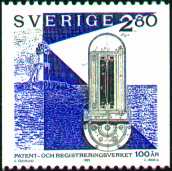
|
In 1858 the first light bulbs using electric power were installed.
Automation started shortly afterwards. On the stamp to the left you
can see the Swedish Gasfeten lighthouse. During 1906 this fire burned
automatically for six months without a failure. Today nearly all
lighthouses are working on full automatic. The traditional job of a
lighthouse keeper becomes more and more obsolete.
Today the lighthouse of Tallin even works with nuclear power. Many
towers are supplied by solar energy as well. And then there are
experiments with laser light. During fog and other bad visibility
conditions this light can be better seen as conventional light.
|

|
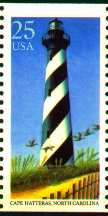
|
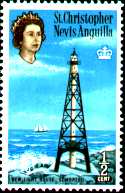
|
In the Middle Ages the lighthouses were build using rocks, stones and
iron. As an excample you can see the masonry (brickwork) and rocks of
the tower of Louisbourg. It was the first Canadian lighthouse. It's
height was 21m und it was finished in 1734. On the US stamp you can
see the lighthouse of Cape Hatteras. The first building dated back to
as early as 1803. The tower you can see today was set up in 1870. It
was build using bricks and had to be repaired several times. You can
recognize it by it's typical diagonal stripe pattern. On the Nevis
stamp you can see the steel construction of the St. Christopher tower.
This bar pattern is called skeleton form.
In the end of the 19th century concrete was introduced. This is still
the material of choice up to today.
|
Today a lighthouse serves multiple purposes. During the night it
provides a visible light and during daytime it is fixed seamark for
the shipping routes. It's equipment includes fog horns and typhoons to
generate warning signals during bad visibility weather. There are
radio beacons for radio bearings - Decca and Loran navigation. It is
used as a weather station and on some towers Racon is installed (see
further down below). Others have indicators for wind speed and wind
direction. Some towers are used for the 12 o'clock time display.
Others are used as pilot stations.
On the stamp you can see the
famous lighthouse of Fastnet Rock in front of the Irish coast.
|
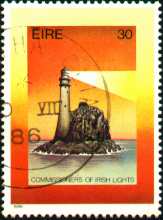
|
The lighthouses are differentiated by the type of light they emit:
- continous lights (constantly shining),
- interrupted lights (time of the light shining is longer than time
of the darkness),
- long blinking lights (time of the light shining is shorter than
time of darkness),
- a flashing (shining light time shorter than two seconds) and
- continous quick light (many flashes).
|
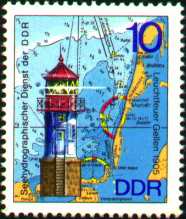
|
The lighthouses are also differentiated by task. There are leading
lights, where two lights must be seen on top of each other in line to
safely enter a port. Beam lights show the sailors the point when to
change course. There are directions lights with different warning
sectors. For example one has to avoid the red sector or can go
straight ahead while travelling in the green sector.
On this
stamp you can see the lighthouse of Gellen on the island of Hiddensee
(Germany) and how it is marked in a sea chart. You can clearly see the
red and white sectors. Also marked are the characteristics of the
light, like, for example the repeat rate or the identification signal.
|
|
For a light the height above sea level is very important. The higher
the light from the more far away it can to be seen, i.e. it's visual
range increases. With knowledge of it's characteristics you can
clearly identify every light on the world during darkness. The
characteristic can be two flashes with a repeat rate of ten seconds,
i.e. the two flashes repeat every ten seconds.
|
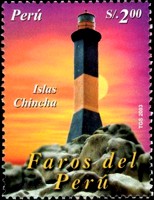
|
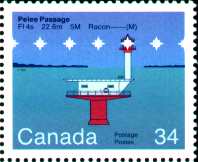
|
On this stamp you can see the tower of Pelee Passage, Lake Erie. It's
characteristic is one flash with a repeat rate of four seconds. The
flashes are depicted as white stars. Additionally to the height and
range of the lighthouse you can see the small notice 'Racon'. This is
an abbreviation for 'radar beacon' and means there is a special radar
response technique installed. If radar rays of closing ships hit the
tower, exact information regarding identification, distance and
bearing are transmitted back to the ships. This special lighthouse at
Pelee Passage uses solar cells to generate energy and has a helicopter
landing pad. Today helicopter stations are usual additions to
lighthouses far off the coast.
|
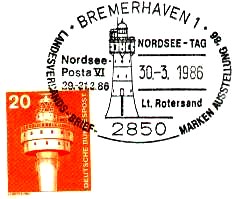
|
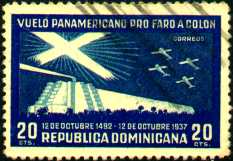
|
Here you can see two lighthouses with great symbolic meanings. To the
left rises the most famous tower in Germany, the 'Roter Sand'
(translated: 'red sand') lighthouse depicted on the postmark, and his
successor, the tower 'Alte Weser' (depicted on the red stamp). The
'Roter Sand' was build from 1880 to 1885 and stayed on duty up to
1964. It's corroded remains were restored by a promotion association
and today it has become a tourist attraction including a hotel! It's
replacement for work, the modern lighthouse 'Alte Weser', helps all
vessels with his sector lights to navigate safely into the ports at
the river Weser.
To the right you can see the Columbus lighthouse of the Dominikanic
Republic. It is a memorial site, a museum for Columbus and a
lighthouse - all in one. Construction work started in 1937 and
finished in 1992! Beside the horizontal light there are 146 additional
headlights which generate a symbolic cross shape of light in the sky.
This tower is depicted on many south american stamps.
|
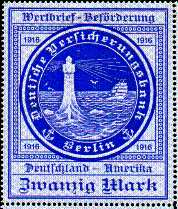
|
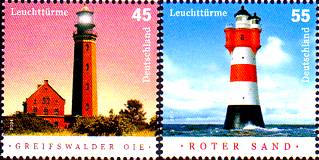
| |
Left and right the lighthouse Roter Sand, in the middle the tower of Greifswalder Oie, Germany.
|
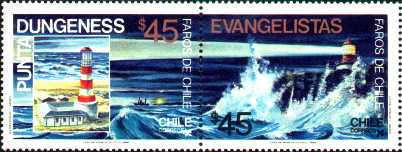
| |
The lighthouse of Punta Dungeness stands at the east entrance of the
Magellan Strait, it's counterpart on the west side ist the lighthouse
Evangelistas.
|
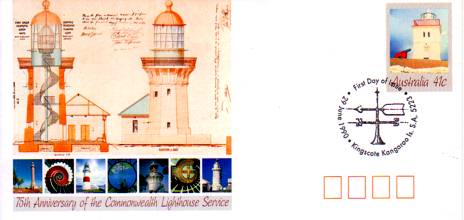
|
There are a lot of stamps and postmarks about lighthouses. Lots of
associations, clubs and many internet pages have been created around
this theme as well.
On this page there are two stamps which refer to life insurance,
i.e. the typical symbolic meaning of a lighthouse. Many people have a
very special relationship to these towers. For them, they symbolize
something like help, a feeling like being at home, a destination
reached, everything O.K., pressed hard but made it, steadfastness, a
temptation resisted or safe arrival after a long
voyage.
Lightships, although serving the same function as
lighthouses, never reached this level of popularity. They were not
visible for most of the people as normally only sailors at sea had
contact and a feeling for these ships.
|
|